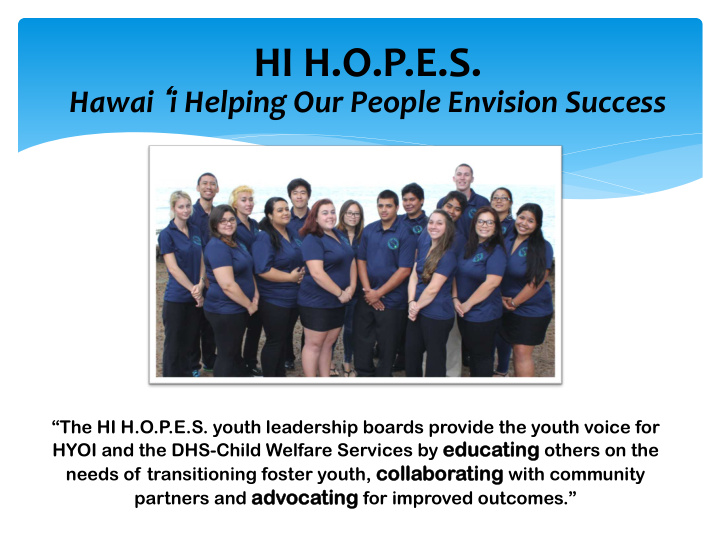



HI ¡H.O.P.E.S. ¡ Hawai ‘ i ¡Helping ¡Our ¡People ¡Envision ¡Success ¡ “The HI H.O.P.E.S. youth leadership boards provide the youth voice for HYOI and the DHS-Child Welfare Services by educ ducating ting others on the needs of transitioning foster youth, colla ollabor borating ting with community partners and advoc ocating ting for improved outcomes.”
http://nfyapc.drupalgardens.com/ ¡
¡ ¡
NFCYAPC Recommendations ü ¡ Aging ¡Out ¡ (October ¡06, ¡2012) ¡ ü ¡Vulnerability ¡-‑ ¡Sex ¡Abuse ¡and ¡Human ¡ ¡Trafficking ¡ ¡ (October ¡06, ¡2012) ¡ ü ¡ Higher ¡Education ¡ (April ¡16, ¡2013) ¡ ü ¡ Mental ¡Health ¡ (April ¡16, ¡2013) ¡ ü ¡ Normalcy ¡(April ¡16, ¡2013) ¡ ü ¡ Well-‑Being ¡(November ¡2014) ¡ ü ¡ Implementation ¡of ¡P.L. ¡113-‑183 ¡ ¡ (Nov. ¡2014) ¡ ¡
The Preventing Sex Trafficking and Strengthening Families Act (Public Law 113-183)
Promoting NORMALCY for Children and Youth in Foster Care Ø Ensure that children in foster care engage in age or developmentally appropriate activities. Ø Institute the ‘ reasonable and prudent parent standard ’ for youth participation in activities. Ø Develop standards and training on the reasonable and prudent parenting standard for foster parents and caregivers. Ø Implement contract requirements so child care institutions always have an individual onsite who is designated to exercise the reasonable and prudent parent standard. Ø Institute liability protections when the reasonable and prudent parenting standard is applied by foster parents. Ø Mandate judicial review of normalcy for youth who have a permanency goal of APPLA. ( Another Planned Permanent Living Arrangement) Ø Require participation of youth age 14 and older in case planning and identification of advisors/advocates. Ø Mandate provision of a list of rights to youth age 14 and older. Ø Mandate inclusion of youth age 14 and older in transition planning. ¡
What is NORMALCY? Age and developmentally-appropriate activities and experiences that will allow children and youth to grow.
Barriers to Normalcy Ø Fears that youth will get HURT and that agencies and individuals will be held LIABLE. Ø Foster youth and foster parents have to obtain PERMISSION for many activities. Ø A foster parent ’ s AUTHORITY is often unclear Ø Congregate care is RESTRICTIVE and does not provide the role of a ‘ prudent parent ’ .
Barriers- Comments from ‘Ohana is Forever Conference Ø Liability Ø Lack of trust between young person and adults Ø Lack of personal connection/relationships Ø Money Ø Transportation Ø Cultural differences Ø Not knowing the law and its requirements Ø Inconsistent visits from social workers and GALs Ø Young people not given a forum to express their needs and wants ¡
Costs of Not Providing Normalcy Ø Foster youth feel SOCIALLY EXCLUDED Ø Hinders WELL-BEING and PERMANENCY Ø SKILLS necessary for adulthood not developed Ø Affects RELATIONSHIP-BUILDING skills Ø Prevents DECISION-MAKING and SELF- LEADERSHIP Ø Increased chance of NEGATIVE LIFE OUTCOMES, HIGHER SOCIAL COST
What is PRUDENT PARENTING? The term ` reasonable and prudent parent standard ' means the standard characterized by careful and sensible parental decisions that maintain the health, safety, and best interests of a child while at the same time encouraging the emotional and developmental growth of the child, that a caregiver shall use when determining whether to allow a child in foster care under the responsibility of the State to participate in extracurricular, enrichment, cultural, and social activities. ¡
IMPLEMENTING THE LAW 1) States should provide a right for children in foster care to engage in age-or developmentally-appropriate activities, and an affirmative obligation on the child welfare agency to provide these opportunities. 2) States should enforce normalcy provisions by requiring a) inclusion of age-appropriate activities in each child’s case plan, b) judicial oversight, and c) youth-friendly grievance procedures. 3) States should supply youth with a document describing their rights under federal and state law and youth-friendly grievance procedures. 4) States should codify the reasonable and prudent parent standard and clarify the scope of decision-making authority and the considerations for decision making. 5) States should afford protections from liability to foster parents and caregivers who follow the reasonable and prudent parent standard.
Recommendations-‘Ohana is Forever Comments Ø Legal protection and guidance for resource caregivers Ø Training and continuing education for resource caregivers Ø Readily accessible information about the law (checklists/ handouts/online/warmline) Ø Supportive relationships between youth/RCG/SW/GAL Ø Open communication with youth Ø Consistent visits and availability of SW/GAL Ø One-on-one visits between youth and SW/GAL/Judgs Ø Encourage youth to attend all court hearings Ø Provide opportunities for youth to share their voice, wants, needs Ø Listen to the youth
NFCYAPC RECOMMENDATIONS • Include youth and alumni of foster care in the development and amending of foster youth rights • Encourage states to educate other stakeholders about our rights • Provide specific guidance about how-and how often-rights must be provided to foster youth • Provide requirements about items that must be included in a list of rights • Develop and implement a youth-friendly grievance process • Do not disqualify foster youth from extracurricular activities based solely on foster care status ¡
Normalcy Poll - 2013 More restrictive placement settings contributed to a lower degree of normalcy. Many foster youth lack control over even minor aspects of their lives. Allowance: 75 % current youth vs. 52% of alumni Club/Sports: 92% current youth vs. 76% of alumni Learning to Cook: 77% current youth vs. 78% of alumni Overnight stays: 46% current youth vs. 54% of alumni Work/Volunteer: 62% current youth vs. 76% of alumni
Recommend
More recommend